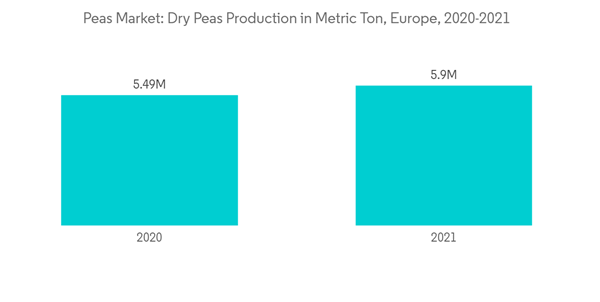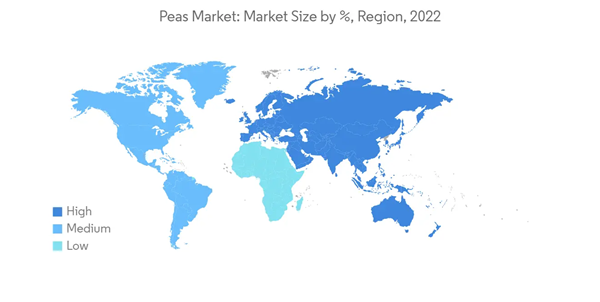Key Highlights
- The increasing world population, mainly in the developing regions, is continuously driving the consumption demand for peas, which also acts as a major driving force behind the growth of the peas market. Yellow peas and green peas are commercially grown varieties, with yellow peas dominating global production.
- The various commercial varieties of peas, such as dry peas, yellow, green, maple, green marrowfat, and Austrian winter peas, are grown globally. The growing risk of obesity and other health issues among the population has shifted them toward a healthy diet. Dried peas, rich in nutrients such as calories, carbs, protein, vitamins, and fibers, help reduce cholesterol levels and the risk of cardiovascular diseases. This is driving the demand for consumption among the population around the globe.
- Besides human consumption, dried peas are also hugely utilized in the medical industry and animal feeds. The multipurpose uses drive the demand for peas.
- The increasing shift to plant-based protein, easy availability, and rising awareness about health are anticipated to drive the consumption of fresh peas globally in the upcoming years.
Peas Market Trends
Growing Demand for Pea Protein Consumption
- The increase in pea protein consumption is attributed to increasing consumer awareness regarding the benefits of preventive healthcare. Due to this, consumers in both developed and developing countries are opting for healthy plant-based protein, which is driving the peas market. Pea proteins extracted from yellow peas dominate the food industry. It is added to veggie burgers, energy bars, popcorn, milk, yogurt, and ice cream. Even in some cases, pea protein replaces soy protein isolates in processed foods.
- The increasing fitness-conscious population and a gradual shift to vegan protein diets from consuming meat products are driving the demand for peas in the market. Owing to their high nutritional qualities and increased western influence, pea proteins have gained popularity even in developing countries.
- Due to the development in developing regions/countries, players in the market are launching new products to meet consumer demand. For instance, in October 2022, Roquette, a global leader in plant-based ingredients and a pioneer of plant proteins, launched a new line of organic pea ingredients, organic pea starch, and organic pea protein in the North American and Europe markets to meet customer demand for protein-rich products in a broad range of on-trend categories. Therefore, the aforementioned factors drive the peas market globally and are anticipated to grow during the forecast period.
Asia-Pacific Dominates the Global Peas Market
- Asia-Pacific is the largest producer of peas globally. In 2021, dried and green peas produced 21.1 million metric tons. Peas are traded worldwide and grow well in winter or a cool environment. This legume originated in China and India but became popular as a commercial legume crop in the mid-century.
- In Asia, China and India are the largest peas-producing countries and have a significant production volume at the global level. India is the world's second-largest producer, consumer, and main importer of dried peas. The total production of peas in India was 6.7 million metric tons in 2021, ranked second in global peas production.
- Despite having huge production, the country cannot meet the demand of its large and rising population. The country's high consumer demand for dried peas has made India the importer of peas in the world. Thus, the factors such as expanding the area under cultivation and increasing concerns toward plant-based proteins, coupled with favorable conditions for the production of peas, are driving the market and are anticipated to grow during the forecast period.
Additional Benefits:
- The market estimate (ME) sheet in Excel format
- 3 months of analyst support
This product will be delivered within 2 business days.










